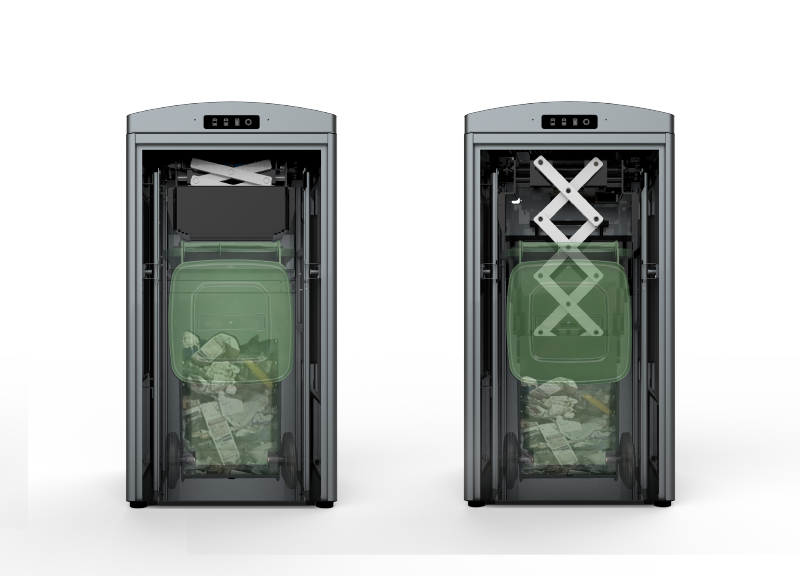Imagine a busy shopping center on a Saturday afternoon. People are buying things, eating snacks and generating trash at a speed that makes it difficult for any waste collection staff to keep up with. A hundred liter wheelie bin in a high traffic area becomes full within a few hours and requires frequent collections during store operations, which also interferes with customers’ shopping experiences. So what could be the solution? Installing larger bins or perhaps asking the cleaning staff to bounce inside the containers to push down the garbage?
Again, imagine a busy town center on a Friday night. Thousands of people are dining, drinking and having fun, while the waste collection staff have finished their day already at 5 pm and are now relaxing at home with their families. By midnight, the containers in high traffic areas are overflowing with waste, creating an ideal environment for insects, vermin, and seagulls. At 6 am, the waste collection staff return to their duties and start cleaning the streets again.
The above examples describe a very common problem in any high foot traffic areas, such as parks, transit stations, sports stadiums, department stores and town centers. The amount of garbage is increasing every year, and so is the money spent on waste collection services. Although installing more bins might stop the problem of waste overflow, there is also a smarter and more ecological way to keep the streets clean: solar-powered waste compacting bins.
The innovation that increases bin capacity by up to 8 times
 Solar-powered waste compactors decrease the frequency of waste collections dramatically by measuring the bin fill-level in real-time and automatically compacting the waste, effectively increasing the bin capacity by up to 8 times. The container which used to fit only 100 liters of trash can suddenly fit up to 800 liters, enabling even the busiest high foot traffic areas to decrease the amount of collections and eliminate overflowing waste bins. The innovative bins are powered by solar panels that store energy in rechargeable batteries and can therefore operate as standalone systems without any exterior wiring. The compactor can be also installed indoors as a hybrid plug-in version, and fully charged it can function several weeks even in the cloudiest weather conditions.
Solar-powered waste compactors decrease the frequency of waste collections dramatically by measuring the bin fill-level in real-time and automatically compacting the waste, effectively increasing the bin capacity by up to 8 times. The container which used to fit only 100 liters of trash can suddenly fit up to 800 liters, enabling even the busiest high foot traffic areas to decrease the amount of collections and eliminate overflowing waste bins. The innovative bins are powered by solar panels that store energy in rechargeable batteries and can therefore operate as standalone systems without any exterior wiring. The compactor can be also installed indoors as a hybrid plug-in version, and fully charged it can function several weeks even in the cloudiest weather conditions.
Besides compacting trash, it also connects with the world
What is cool about solar-powered waste compactor bins is that they are connected to the internet and communicate the information they collect in real-time through a wireless 2G/3G transmission to a smart waste management platform. By sending the compaction and fill-level information to the data analytics platform, the smart bin enables waste collection managers to understand the location and times of waste collections, and improves the way the trash is collected by recommending optimal collection routes. This means that there can be fewer collection trucks on the road for less time, spending less fuel and creating less pollution.
Solar-powered waste compactor bins also commonly include a number of other features, such as LED/LCD panels for generating an additional revenue stream through advertisements, a router that allows the bins to act as Wi-Fi hotspots, and various safety features such as fire and motion detectors. Most importantly, the bins reduce operational costs of waste collection by up to 80%.
How a retail chain improved their waste collection efficiency
In South Korea, a retail company with 48 department stores around the country had serious problems with their waste collections. Most notably, their bins in high traffic areas became full too quickly, requiring cleaning staff to collect the bins up to four times on weekdays and seven times on weekends. The frequent waste collections not only meant high operational costs but also interfered with their customers’ shopping experiences.
In order to improve the situation, the retail chain installed 24 Clean CUBE smart bins in central spots of their department stores, as well as near the restrooms. 8 of the 24 Clean Cubes were equipped with LED advertisement panels to promote various storewide events at the department store. As a result, the company saw their collection efficiency increasing from 4-7 times a day to once a day, and they also received a high advertising effect from the LED advertisement panels. After a successful pilot period, the retail chain plans to make Clean CUBE a standard in all of their nationwide locations.
